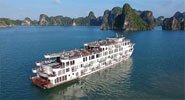The Legend of Halong Bay: Discover Myths Behind The Names
Halong bay is known for its impressive natural beauty, and although it was recently crowned one of the new Seven Natural Wonders of the world, not many people know about the legend of the bay’s origins.
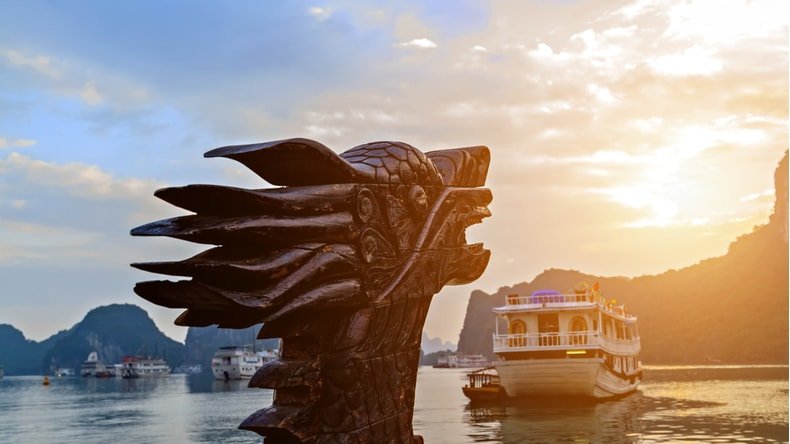
- The name "Halong" means "descending dragon" in Vietnamese, and the bay is steeped in legend and folklore.
- The legend is also a part of the general belief that Vietnamese people have Dragon's origins.
The Origin of the Name
In Vietnamese, the name “Hạ Long”, literally translated, means "descending dragon". According to ancient mythology, the Vietnamese people are said to have descended from dragons themselves – with this in mind, the legend of Halong Bay promises to be a fascinating one indeed.
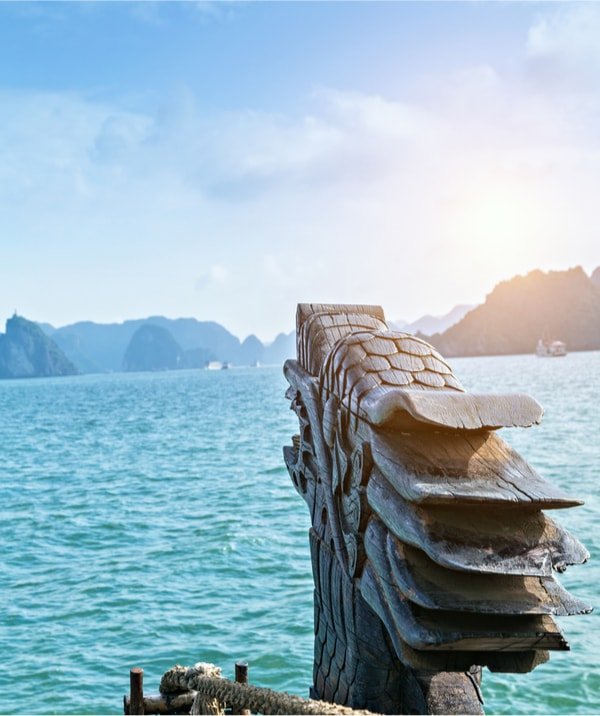 Wooden Dragon Head, a spiritual symbol on Halong junk boats.
Wooden Dragon Head, a spiritual symbol on Halong junk boats.
The Legend of Ha Long
Legend has it that shortly after the formation of the country, Vietnamese people had to fight back against hostile invaders attempting to enter the country through the sea. Refusing to allow his people to be defeated, the revered Jade Emperor called upon the Gods to send the Mother Dragon and her children to help the Vietnamese people in defeating their enemies.
The Mother Dragon and her children did not hesitate, they heeded the Emperor’s call and ferociously came down on to face the attackers. Although the invaders were powerful and on the verge of winning, the dragons destroyed the them in a blaze of fire.
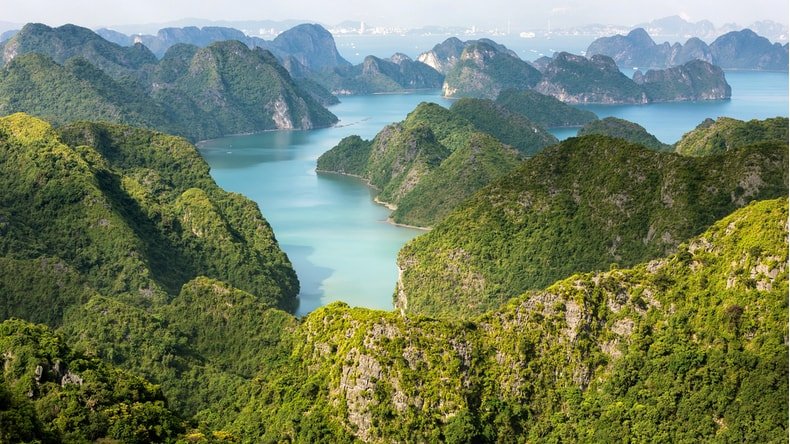 Thousands of limestone islands in Halong bay today!
Thousands of limestone islands in Halong bay today!
As the enemy was defeated, giant emeralds appeared and scattered along the bay. According to legend these emeralds were actually the teeth of the Mother Dragon and her children. The emeralds were left behind to create an impossible-to-penetrate barrier to discourage any future invasions. Peace returned to the country and after a thousand years, these walls of emeralds transformed into the islands and islets that you can admire in Halong Bay today.
After their triumph in Halong Bay, the Mother Dragon and her children never returned to the heavens from which they were summoned. Instead, they stayed and adopted the form of humans to help the Vietnamese people farm, raise cattle, reclaim land and thrive.
To commemorate the intervention of the Mother Dragon and her children, Vietnamese people named the bay: "Hạ Long" and the area where her children landed, "Bái Tử Long"; the latter meaning "Bowing down and showing respect to the dragon's children".
The Legend of Dau Go Cave
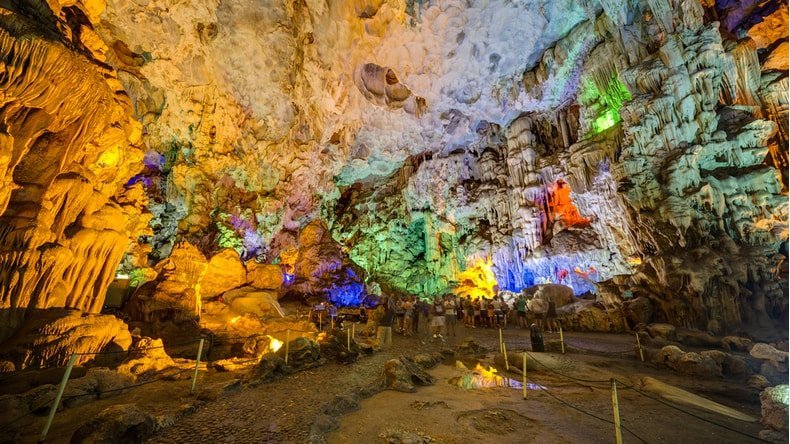
Dau Go is a big cave with an enormous entrance, at 17 meters wide and 12 meters high. It sits 27 meters above sea level and was formed during the Pleistocene era 2 million years ago. Today it remains in perfect condition, exhibiting an ancient beauty that is rarely seen on our planet any more.
The name Dau Go can be translated as ‘Wooden Head’ and there are three different stories as to where that name came from.
- The first story is a historic one. During the war against the Nguyen invaders in the 13th century, soldiers of the Tran Dynasty put wooden spears in the river Bach Dang (Yen Hung) as a trap to defeat enemy soldiers. Because the ‘wooden heads’ of the spears the cave was called Dau Go to commemorate their victory.
- In the second theory it’s been said that during stormy days fishermen would take shelter on Dau Go island. This is due to the fact that the island is bow shaped right in front of the entrance of the cave, which gives fishermen good shelter. After the storms the boats had to be repaired and in the process the fishermen left behind a lot of wood. This wood would be found at the head of the cave, hence the name ‘Wooden Cave’.
- The last story is the most straightforward of the three. It says that from a distance the cave looks like a giant wooden tree, that’s why the locals began to call it ‘Wooden Head’ cave.
Further reading: A guide to Dau Go cave
The Legend of Trinh Nu Cave

The legend of Trinh Nu (Virgin) Cave is a tragic love story. The cave is located on Bo Hon Island which is also where Sung Sot (surprise) Cave is located.
The story goes as follows: once upon a time there was a beautiful fisherman’s daughter. She came from a poor family but one day a rich man, upon seeing her beauty, proposed to marry her. The girl was already engaged to another fisherman whom she loved dearly, so she declined the rich man’s proposal. Outraged by her dismissal, he banned her and her entire family to a desert island.
The girl’s fiance scoured the bay trying to find his long lost love but all to no avail, and on a rainy and stormy night, starving and exhausted, the girl turned to stone. The fiance, who was still searching for her, got caught in the storm and his boat capsized. He washed ashore on the same deserted island and in a glimpse, he saw her.
He tried reaching out to her, to talk to her , but it was no use: the wind swept away his words. He tried to get her attention by slamming rocks into a cliff, all to no effect. The boy tried and tried until he was too exhausted and he himself turned to stone as well.
The place where the girl turned to stone was Trinh Nu Cave. Nowadays there is a natural statue of her in front of the cave. The statue of the petrified man facing the Trinh Nu cave is also still there to this day. Since the two lovers never had a chance to marry, locals decided to call the cave ‘Trinh Nu’ or ‘Virgin’.
The Legend of Hanh Cave
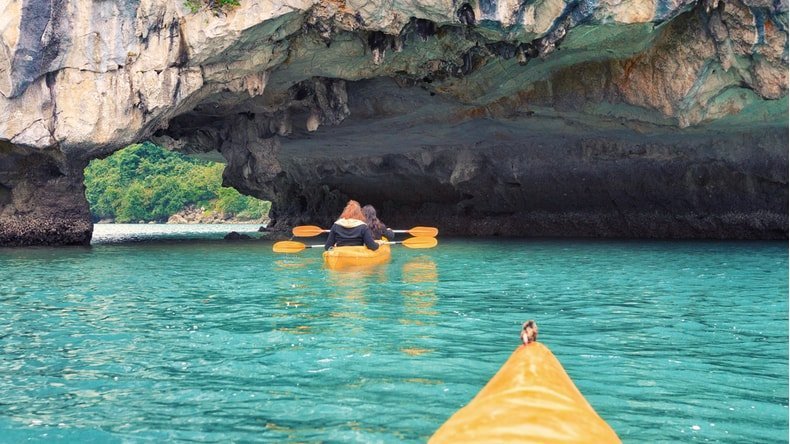
Hanh Cave is the longest cave in Halong Bay. Even though the name of the cave itself isn’t tied to a legend, there’s still an interesting, but tragic, story to be told about the cave. The story goes that one day three beautiful girls took their boat into the cave.
Lost in the magnificence and splendor of the cave they forgot all about the time and didn’t notice the tide coming in. Not having enough time to get out of the cave, the three girls perished. Out of sympathy for these three girls, local fishermen have built a temple to honor them.
This small temple called ‘Ba Co’ or "Three Girls", still remains there till this day.
The Legend of Cat Ba island
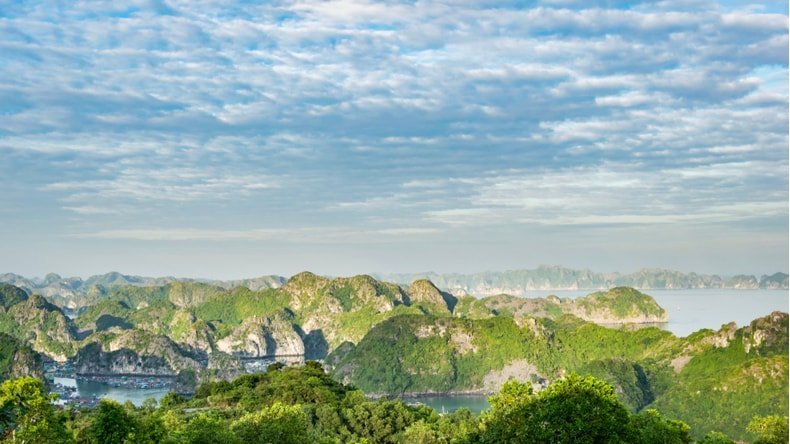
Cat Ba is the largest island in Halong Bay. The original name of the island was ‘Các Bà’ which roughly translates as ‘Women’. There is a folktale story about the origin of this name. According to local legend, once upon a time, all women on the island had to take care of homes, logistics and transportation while all the men were off fighting wars defending the island. At this time, the island was called ‘Các Bà’ or simply ‘Women’ island.
Conclusion
These legends are passed down through generations and have become an important part of the culture and history of the region, making Halong Bay not only a natural wonder but also a cultural treasure.



